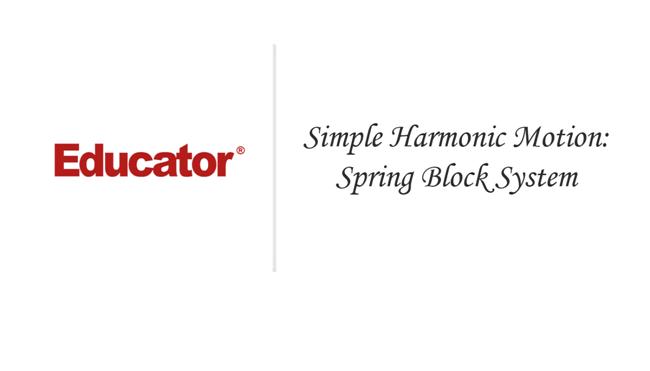

Professor Jishi
Simple Harmonic System Spring Block System
Slide Duration:Table of Contents
1h 17m 37s
- Intro0:00
- What is Physics?1:35
- Physicists and Philosophers1:57
- Differences Between2:48
- Experimental Observations3:20
- Laws (Mathematical)3:48
- Modification of Laws/Experiments4:24
- Example: Newton's Laws of Mechanics5:38
- Example: Einstein's Relativity6:18
- Units8:50
- Various Units9:37
- SI Units10:02
- Length (meter)10:18
- Mass (kilogram)10:35
- Time (second)10:51
- MKS Units (meter kilogram second)11:04
- Definition of Second11:55
- Definition of Meter14:06
- Definition of Kilogram15:21
- Multiplying/Dividing Units19:10
- Trigonometry Overview21:24
- Sine and Cosine21:31
- Pythagorean Theorem23:44
- Tangent24:15
- Sine and Cosine of Angles24:35
- Similar Triangles25:54
- Right Triangle (Opposite, Adjacent, Hypotenuse)28:16
- Other Angles (30-60-90)29:16
- Law of Cosines31:38
- Proof of Law of Cosines33:03
- Law of Sines37:03
- Proof of Law of Sines38:03
- Scalars and Vectors41:00
- Scalar: Magnitude41:22
- Vector: Magnitude and Direction41:52
- Examples42:31
- Extra Example 1: Unit Conversion-1
- Extra Example 2: Law of Cosines-2
- Extra Example 3: Dimensional Analysis-3
1h 10m 31s
- Intro0:00
- Graphical Method0:10
- Magnitude and Direction of Two Vectors0:40
- Analytical Method or Algebraic Method8:45
- Example: Addition of Vectors9:12
- Parallelogram Rule11:42
- Law of Cosines14:22
- Law of Sines18:32
- Components of a Vector21:35
- Example: Vector Components23:30
- Introducing Third Dimension31:14
- Right Handed System33:06
- Specifying a Vector34:44
- Example: Calculate the Components of Vector36:33
- Vector Addition by Means of Components41:23
- Equality of Vectors47:11
- Dot Product48:39
- Extra Example 1: Vector Addition-1
- Extra Example 2: Angle Between Vectors-2
- Extra Example 3: Vector Addition-3
1h 6m 17s
- Intro0:00
- Dot Product0:12
- Vectors in 3 Dimensions1:36
- Right Handed System2:15
- Vector With 3 Components (Ax,Ay,Az)3:00
- Magnitude in 2 Dimension3:59
- Magnitude in 3 Dimension3:40
- Dot Product of i*i7:21
- Two Vectors are Perpendicular8:50
- A.B13:34
- Angle Between Two Vectors17:27
- Given Two Vectors17:35
- Calculation Angle Between Vectors with (A.B)18:25
- Cross Product23:14
- Cross Product of AxB23:42
- Magnitude of C=AxB cos Theta24:35
- Right Hand Rule27:07
- BxA28:40
- Direction of IxJ=K31:04
- JxK33:15
- KxI35:00
- Evaluation in Terms of Determinants39:28
- Two Vectors A and B with Magnitude and Direction39:35
- Calculate AxB40:08
- Example49:59
- Extra Example 1: Perpendicular Vectors-1
- Extra Example 2: Area of Triangle Given Vertices-2
1h 28m 27s
- Intro0:00
- Definition and Geometric Interpretation1:06
- Example: F(x) is a Polynomial1:14
- Example: Parabola2:48
- F(x+h)4:04
- F(x+h)-F(x)/h5:38
- Slope of the Tangent9:53
- df/dx=f'10:30
- Derivatives of Power of x13:11
- F(x)=1 or Any Constant =013:27
- F(x) =x = 115:13
- F(x)= x2 = 2x16:15
- F(x)= x3 = 3x218:26
- Derivatives of Sin(x), Cos(x) , Exp(x)22:40
- f(x)=Six x =cos(x)22:51
- Cos(x)=1 X= in Radians27:50
- Sin(x)=1 X= in Radians28:55
- e^x where x= in Radians29:49
- Derivative of u(x) v(x)39:17
- Derivative of Product of Two Functions f(x) =x^2 Sin(x)39:30
- Derivative of u(x)/v(x)46:15
- F(u/v)= f(u(x+h)/v(x+h)46:23
- Chain Rule51:40
- Example: F(x) =(x^2-1)^551:53
- F(x)=Sin 3x56:51
- F(x) =e^-2x58:21
- Extra Example 1: Minima and Maxima-1
- Extra Example 2: Derivative-2
- Extra Example 3: Fermat's Principle to Derive Snell's Law-3
1h 13m 28s
- Intro0:00
- Definite Integrals0:20
- F(x)0:29
- Area10:43
- Indefinite Integrals13:53
- Suppose Function f(y)=∫f(y) dy15:07
- g(x)=∫ f(x) dx21:45
- ∫2 dx=2x+c22:40
- Evaluation of Definite Integrals25:20
- ∫f(x') dx'=g(x)25:35
- Integral of Sin(x) ,Cos(x) , and Exp(x)36:18
- ∫ sinx dx=-cos x+c36:56
- ∫ cosx dx=sin x+c39:32
- ∫ co2x dx=sin2x40:09
- ∫Cosωdt=1/ωsin ωdt42:42
- ∫e^x dx=e^x+c43:32
- Integration by Substitution45:23
- ∫x(x^2 -1)dx46:01
- Integration by Parts52:30
- d/dx=(uv)'52:45
- ∫udv=∫d(uv)-∫Vdu =uv-∫vdu54:20
- ∫xe^x dx/dv56:11
- Extra Example 1: Integral-1
- Extra Example 2: Integral-2
1h 19m 35s
- Intro0:00
- Position, Distance, and Displacement0:12
- Position of the Object0:30
- Distance Traveled by The Object5:34
- Displacement of The Object9:05
- Average Speed Over a Certain Time Interval14:46
- Example Of an Object15:15
- Example: Calculating Average Speed20:19
- Average Velocity Over a Time Interval22:22
- Example Calculating Average Velocity of an Object22:45
- Instantaneous Velocity30:45
- Average Acceleration Over a Time Interval40:50
- Example: Average Acceleration of an Object42:01
- Instantaneous Acceleration47:17
- Example: Acceleration of Time T47:33
- Example with Realistic Equation49:52
- Motion With Constant Acceleration: Kinematics Equation53:39
- Example: Motion of an Object with Constant Acceleration53:55
- Extra Example 1: Uniformly Accelerated Motion-1
- Extra Example 2: Catching up with a Car-2
- Extra Example 3: Velocity and Acceleration-3
47m 45s
- Intro0:00
- Velocity and Acceleration0:27
- Particle moves In x Direction0:35
- Instantaneous Velocity for Δt =03:05
- Acceleration (Change in Time) v(t+=Δt)-v(t) /Δt4:58
- Example8:08
- x(t) =(-4+3t+2t^2)8:18
- Finding Average velocity at 10sec8:45
- V at t=3s10:28
- x(t) =0 ,0.2 sin (2t)12:20
- Finding Velocity12:50
- Constant Acceleration15:29
- Object Moving with Constant Acceleration15:40
- Find Velocity and Position at Later Time t18:23
- v=∫a dt19:50
- V(t) =v0+at23:33
- v(t) =dx/dt x=∫vdt24:14
- T=v-v0/a29:26
- Extra Example 1: Velocity and Acceleration-1
- Extra Example 2: Particle Acceleration-2
1h 28m 59s
- Intro0:00
- Acceleration Due to Gravity0:11
- Dropping an Object at Certain Height0:25
- Signs : V , A , D7:07
- Example: Shooting an Object Upwards7:34
- Example: Ground To Ground12:13
- Velocity at Maximum Height14:30
- Time From Ground to Ground23:10
- Shortcut: Calculate Time Spent in Air24:07
- Example: Object Short Downwards30:19
- Object Short Downwards From a Height H30:30
- Use of Quadratic Formula36:23
- Example: Bouncing Ball41:00
- Ball Released From Certain Height41:22
- Time Until Stationary43:10
- Coefficient of Restitution46:40
- Example: Bouncing Ball. Continued53:02
- Extra Example 1: Object Shot Off Cliff-1
- Extra Example 2: Object Released Off Roof-2
- Extra Example 3: Rubber Ball (Coefficient of Restitution)-3
1h 8m 38s
- Intro0:00
- Position, Displacement, Velocity, Acceleration0:10
- Position of an Object in X-Y Plane0:19
- Displacement of an Object2:48
- Average Velocity4:30
- Instantaneous Velocity at Time T5:22
- Acceleration of Object8:49
- Projectile Motion9:57
- Object Shooting at Angle10:15
- Object Falling Vertically14:48
- Velocity of an Object18:17
- Displacement of an Object19:20
- Initial Velocity Remains Constant21:24
- Deriving Equation of a Parabola25:23
- Example: Shooting a Soccer Ball25:25
- Time Ball Spent in Air (Ignoring Air Resistance)27:48
- Range of Projectile34:49
- Maximum Height Reached by the Projectile36:25
- Example: Shooting an Object Horizontally40:38
- Time Taken for Shooting42:34
- Range46:01
- Velocity Hitting Ground46:30
- Extra Example 1: Projectile Shot with an Angle-1
- Extra Example 2: What Angle-2
1h 1m 54s
- Intro0:00
- Uniform Circular Motion0:15
- Object Moving in a Circle at Constant Speed0:26
- Calculation Acceleration3:30
- Change in Velocity3:45
- Magnitude of Acceleration14:21
- Centripetal Acceleration18:15
- Example: Earth Rotating Around The Sun18:42
- Center of the Earth20:45
- Distance Travelled in Making One Revolution21:34
- Acceleration of the Revolution23:37
- Tangential Acceleration and Radial Acceleration25:35
- If Magnitude and Direction Change During Travel26:22
- Tangential Acceleration27:45
- Example: Car on a Curved Road29:50
- Finding Total Acceleration at Time T if Car is at Rest31:13
- Extra Example 1: Centripetal Acceleration on Earth-1
- Extra Example 2: Pendulum Acceleration-2
- Extra Example 3: Radius of Curvature-3
1h 29m 51s
- Intro0:00
- Force0:21
- Contact Force (Push or Pull)1:02
- Field Forces1:49
- Gravity2:06
- Electromagnetic Force2:43
- Strong Force4:12
- Weak Force5:17
- Contact Force as Electromagnetic Force6:08
- Focus on Contact Force and Gravitational Force6:50
- Newton's First Law7:37
- Statement of First Law of Motion7:50
- Uniform Motion (Velocity is Constant)9:38
- Inertia10:39
- Newton's Second Law11:19
- Force as a Vector11:35
- Statement of Second Law of Motion12:02
- Force (Formula)12:22
- Example: 1 Force13:04
- Newton (Unit of Force)13:31
- Example: 2 Forces14:09
- Newton's Third Law19:38
- Action and Reaction Law19:46
- Statement of Third Law of Motion19:58
- Example: 2 Objects20:15
- Example: Objects in Contact21:54
- Example: Person on Earth22:54
- Gravitational Force and the Weight of an Object24:01
- Force of Attraction Formula24:42
- Point Mass and Spherical Objects26:56
- Example: Gravity on Earth28:37
- Example: 1 kg on Earth35:31
- Friction37:09
- Normal Force37:14
- Example: Small Force40:01
- Force of Static Friction43:09
- Maximum Force of Static Friction46:03
- Values of Coefficient of Static Friction47:37
- Coefficient of Kinetic Friction47:53
- Force of Kinetic Friction48:27
- Example: Horizontal Force49:36
- Example: Angled Force52:36
- Extra Example 1: Wire Tension-1
- Extra Example 2: Car Friction-2
- Extra Example 3: Big Block and Small Block-3
1h 24m 35s
- Intro0:00
- Acceleration on a Frictionless Incline0:35
- Force Action on the Object(mg)1:31
- Net Force Acting on the Object2:20
- Acceleration Perpendicular to Incline8:45
- Incline is Horizontal Surface11:30
- Example: Object on an Inclined Surface13:40
- Rough Inclines and Static Friction20:23
- Box Sitting on a Rough Incline20:49
- Maximum Values of Static Friction25:20
- Coefficient of Static Friction27:53
- Acceleration on a Rough Incline29:00
- Kinetic Friction on Rough Incline29:15
- Object Moving up the Incline33:20
- Net force on the Object36:36
- Example: Time to Reach the Bottom of an Incline41:50
- Displacement is 5m Down the Incline45:26
- Velocity of the Object Down the Incline47:49
- Extra Example 1: Bottom of Incline-1
- Extra Example 2: Incline with Initial Velocity-2
- Extra Example 3: Moving Down an Incline-3
1h 10m 3s
- Intro0:00
- Atwood's Machine0:19
- Object Attached to a String0:39
- Tension on a String2:15
- Two Objects Attached to a String2:23
- Pulley Fixed to the Ceiling, With Mass M1 , M24:53
- Applying Newton's 2nd Law to Calculate Acceleration on M1, M29:21
- One Object on a Horizontal Surface: Frictionless Case17:36
- Connecting Two Unknowns, Tension and Acceleration20:27
- One Object on a Horizontal Surface: Friction Case23:57
- Two Objects Attached to a String with a Pulley24:14
- Applying Newton's 2nd Law26:04
- Tension of an Object Pulls to the Right27:31
- One of the Object is Incline : Frictionless Case32:59
- Sum of Two Forces on Mass M234:39
- If M1g is Larger Than M2g36:29
- One of the Object is Incline : Friction Case40:29
- Coefficient of Kinetic Friction41:18
- Net Force Acting on M245:12
- Extra Example 1: Two Masses on Two Strings-1
- Extra Example 2: Three Objects on Rough Surface-2
- Extra Example 3: Acceleration of a Block-3
1h 13m 28s
- Intro0:00
- What Does a Scale Measure0:11
- Example: Elevator on a Scale0:22
- Normal Force4:57
- Apparent Weight in an Elevator7:42
- Example: Elevator Starts Moving Upwards9:05
- Net Force (Newton's Second Law)11:34
- Apparent Weight14:36
- Pendulum in an Accelerating Train15:58
- Example: Object Hanging on the Ceiling of a Train16:15
- Angle In terms of Increased Acceleration22:04
- Mass and Spring in an Accelerating Truck23:40
- Example: Spring on a Stationary Truck23:55
- Surface of Truck is Frictionless27:38
- Spring is Stretched by distance X28:40
- Cup of Coffee29:55
- Example: Moving Train and Stationary Objects inside Train30:05
- Train Moving With Acceleration A32:45
- Force of Static Friction Acting on Cup36:30
- Extra Example 1: Train Slows with Pendulum-1
- Extra Example 2: Person in Elevator Releases Object-2
- Extra Example 3: Hanging Object in Elevator-3
1h 1m 15s
- Intro0:00
- Object Attached to a String Moving in a Horizontal Circle0:09
- Net Force on Object (Newton's Second Law)1:51
- Force on an Object3:03
- Tension of a String4:40
- Conical Pendulum5:40
- Example: Object Attached to a String in a Horizontal Circle5:50
- Weight of an Object Vertically Down8:05
- Velocity And Acceleration in Vertical Direction11:20
- Net Force on an Object13:02
- Car on a Horizontal Road16:09
- Net Force on Car (Net Vertical Force)18:03
- Frictionless Road18:43
- Road with Friction22:41
- Maximum Speed of Car Without Skidding26:05
- Banked Road28:13
- Road Inclined at an Angle ø28:32
- Force on Car29:50
- Frictionless Road30:45
- Road with Friction36:22
- Extra Example 1: Object Attached to Rod with Two Strings-1
- Extra Example 2: Car on Banked Road-2
- Extra Example 3: Person Held Up in Spinning Cylinder-3
50m 29s
- Intro0:00
- Normal Force by a Pilot Seat0:14
- Example : Pilot Rotating in a Circle r and Speed s0:33
- Pilot at Vertical Position in a Circle of Radius R4:18
- Net Force on Pilot Towards Center (At Bottom)5:53
- Net Force on Pilot Towards Center (At Top)7:55
- Object Attached to a String in Vertical Motion10:46
- Example: Object in a Circle Attached to String10:59
- Case 1: Object with speed v and Object is at Bottom11:30
- Case 2: Object at Top in Vertical Motion15:24
- Object at Angle ø (General Position)17:48
- 2 Radial Forces (Inward & Outward)20:32
- Tension of String23:44
- Extra Example 1: Pail of Water in Vertical Circle-1
- Extra Example 2: Roller Coaster Vertical Circle-2
- Extra Example 3: Bead in Frictionless Loop-3
1h 24m 46s
- Intro0:00
- Work in One Dimension: Constant Force0:11
- Particle Moving in X-Axis0:24
- Displacement Δx=x2-x11:35
- Work Done by the Force W=FΔX2:25
- Example: Object Being Pushed for 10 m (Frictionless case)3:31
- Example: Elevator Descends with constant Velocity5:37
- Work by Tension9:06
- Work in One Dimension: Variable Force11:28
- Object Displaced from a to b Under Action of Force12:06
- Total Work= F(x1) Δx119:48
- Special Case : F(x) =F22:56
- Work Done by a Spring24:30
- Spring Attached to a Object24:42
- Spring Stretched25:40
- Spring Compressed and Released30:30
- Hookes Law32:05
- W=∫F(x) dx ,Initial Position to Final Position36:25
- Work in Three Dimension: Constant Force41:54
- 3 Components Of 3 Dimensions45:45
- Work Done By F=F.Δx47:30
- Example48:58
- Object Moves Up and Inclined49:10
- Work Done by Gravity=F.Δr49:50
- W=F.Δr= -mgz53:50
- Work Done By Normal Force=054:33
- Work in Three Dimension: Variable Force55:45
- Object Moving From A to B with Time56:03
- W=∫f.dr57:45
- Extra Example 1: Work Done By Force-1
- Extra Example 2: Mass on Half Ring-2
- Extra Example 3: Force with Two Paths-3
1h 12m 53s
- Intro0:00
- Work Kinetic Energy Theorem0:16
- Object Moves in 3 Dimensions1:51
- Work Done by Net Force =W=∫f.dr3:27
- W=Change in Kinetic Energy15:11
- Example16:00
- Object Moving on Surface with Mass 10 N16:12
- Using Newton's Second Law18:26
- Using Work Kinetic Energy Theorem21:32
- Gravitational Potential Energy24:30
- Example of a Particle in 3 Dimensions24:47
- Work Done By Force of Gravity26:09
- Conservation of Energy36:37
- Object in a Projectile36:48
- Work Done by Gravity39:50
- Example43:45
- Frictionless Track44:20
- Example50:49
- Pendulum: Object Attached to a String at Height H51:07
- Finding Tension in a String52:20
- Extra Example 1: Object Pulled by Angled Force-1
- Extra Example 2: Projectile Shot at Angle-2
1h 32m 50s
- Intro0:00
- Conservative Forces0:10
- Given a Force4:01
- Consider a Particle Moves from P1 to P2 on Path5:40
- Work Done by Force8:28
- Example14:56
- Gravity15:20
- Spring with Block Moves and Stretched17:36
- Friction is Net Conservative23:29
- Path 1 Straight27:04
- Along Path 230:07
- Potential Energy by a Conservative Force33:23
- Choose Reference Point (Potential Energy =0)33:51
- Define Potential Energy at Point P35:23
- Conservation of Energy40:58
- Object Moving from P1 -P241:50
- Work Kinetic Energy Theorem41:58
- Potential Energy of a Spring48:42
- Spring Stretched with Mass M, Find Potential Energy49:13
- Example53:45
- Force Acting on Particle in One Dimension54:10
- Extra Example 1: Work Done By Gravity-1
- Extra Example 2: Prove Constant Force is Conservative-2
- Extra Example 3: Work Done by Force-3
- Extra Example 4: Compression of Spring-4
1h 7m 48s
- Intro0:00
- In Presence of Friction0:13
- Work Energy Theorem3:05
- Work Done BY Friction is Negative6:51
- Example10:12
- Object on Inclined Surface with Friction10:20
- Heat, Magnitude by Friction12:42
- Work Done By Friction13:01
- Calculation of the Force From The Potential Energy19:15
- Defining Potential Energy with Conservation of Energy19:35
- Potential Energy and Equilibrium31:16
- Spring Stretched with Mass M31:28
- Stable Equilibrium35:52
- Unstable Equilibrium40:50
- Example41:02
- Two Objects or Two Atoms41:12
- Leonard John's Potential42:15
- Power47:38
- Rate at Force Work Done47:54
- Average Power49:01
- Instant Power Delivered at Time t49:20
- Horse Power53:10
- Extra Example 1: Force from Potential Energy-1
- Extra Example 2: Mass with Two Springs-2
- Extra Example 3: Block Pulled with Friction-3
1h 11m 58s
- Intro0:00
- Spring Loaded Gun0:26
- Spring with Bullet0:43
- Finding the Force Constant if Mass of Bullet is Given2:48
- Compression of a Spring5:10
- Sliding Object11:33
- Object Sliding on a Frictionless Surface12:15
- Spring at the End of a Slide12:46
- Using Conservation of Energy K1+u1=K2+U215:06
- Finding Velocity and Energy17:36
- Block Spring System with Friction33:05
- Spring is Unstretched at Equilibrium33:35
- Spring is Compressed33:57
- Finding Total Energy39:02
- Losing Contact on a Circular Track46:16
- Objects Slides on a Circular Track47:25
- Normal Force=048:10
- Centripetal Force48:57
- Finding Velocity at Given Angle49:25
- Energy at the Top50:55
- Contact Lost54:55
- Horse Pulling a Carriage56:07
- Horse Power56:40
- Power=FV57:11
- Extra Example 1: Elevator with Friction-1
- Extra Example 2: Loop the Loop-2
1h 31m 19s
- Intro0:00
- Linear Momentum0:10
- Example: Object of Mass m with Velocity v0:25
- Example: Object Bounced on a Wall1:08
- Momentum of Object Hitting a Wall2:20
- Change in Momentum4:10
- Force is the Rate of Change of Momentum4:30
- Force=Mass*Acceleration (Newton's Second Law)4:45
- Impulse10:24
- Example: Baseball Hitting a Bat10:40
- Force Applied for a Certain Time11:50
- Magnitude Plot of Force vs Time13:35
- Time of Contact of Baseball = 2 milliseconds (Average Force by Bat)17:42
- Collision Between Two Particles22:40
- Two Objects Collide at Time T23:00
- Both Object Exerts Force on Each Other (Newton's Third Law)24:28
- Collision Time25:42
- Total Momentum Before Collision = Total momentums After Collision32:52
- Collision33:58
- Types of Collisions34:13
- Elastic Collision ( Mechanical Energy is Conserved)34:38
- Collision of Particles in Atoms35:50
- Collision Between Billiard Balls36:54
- Inelastic Collision (Rubber Ball)39:40
- Two Objects Collide and Stick (Completely Inelastic)40:35
- Completely Inelastic Collision41:07
- Example: Two Objects Colliding41:23
- Velocity After Collision42:14
- Heat Produced=Initial K.E-Final K.E47:13
- Ballistic Pendulum47:37
- Example: Determine the Speed of a Bullet47:50
- Mass Swings with Bulled Embedded49:20
- Kinetic Energy of Block with the Bullet50:28
- Extra Example 1: Ball Strikes a Wall-1
- Extra Example 2: Clay Hits Block-2
- Extra Example 3: Bullet Hits Block-3
- Extra Example 4: Child Runs onto Sled-4
1h 18m 48s
- Intro0:00
- Elastic Collision: One Object Stationary0:28
- Example: Stationary Object and Moving Object0:42
- Conservation of Momentum2:48
- Mechanical Energy Conservation3:43
- Elastic Collision: Both Objects Moving17:34
- Example: Both Objects Moving Towards Each Other17:48
- Kinetic Energy Conservation19:20
- Collision With a Spring-Block System29:17
- Example: Object of Mass Moving with Velocity29:30
- Object Attached to Spring of Mass with Velocity29:50
- Two Objects Attached to a Spring31:30
- Compression of Spring after Collision33:41
- Before Collision: Total Energy (Conservation of Energy)37:25
- After Collision: Total Energy38:49
- Collision in Two Dimensions42:29
- Object Stationary and Other Object is Moving42:46
- Head on Collision (In 1 Dimension)44:07
- Momentum Before Collision45:45
- Momentum After Collision46:06
- If Collision is Elastic (Conservation of Kinetic Energy) Before Collision50:29
- Example51:58
- Objects Moving in Two Directions52:33
- Objects Collide and Stick Together (Inelastic Collision)53:28
- Conservation of Momentum54:17
- Momentum in X-Direction54:27
- Momentum in Y-Direction56:15
- Maximum Height after Collision-1
- Extra Example 2: Two Objects Hitting a Spring-2
- Extra Example 3: Mass Hits and Sticks-3
1h 33m 46s
- Collection of Particles0:13
- System of Coordinates0:40
- Coordinates of Center of Mass2:25
- Four Particles10:10
- Center of Mass at Xcm13:20
- Center of Mass at Ycm15:07
- Extended Objects17:00
- Consider a Object17:30
- Dividing Object in to Smaller Particles19:07
- Divide the Volume N into Pieces23:10
- Center of Mass of a Rod31:02
- Total Mass of Rod35:30
- Center of Mass of a Right Angle42:27
- Right Triangle Placed in Coordinates42:40
- Tiny Strip on a Triangle45:05
- Intersection of a Point56:19
- Extra Example 1: Center of Mass Two Objects-1
- Extra Example 2: Bent Rod Center of Mass-2
- Extra Example 3: Triangle Center of Mass-3
1h 19m 15s
- Intro0:00
- Motion of a System of Particles0:53
- Position Vector of Center of Mass2:30
- Total Momentum7:08
- Net Force Acting on a Particle9:32
- Exploding a Projectile19:12
- Shooting a Projectile in x-z Plane19:50
- Projectile Explodes into 2 pieces of Equal Mass27:19
- Rocket Propulsion35:09
- Rocket with Mass m and Velocity v35:25
- Rocket in Space53:39
- Rocket in Space with Speed=3000m/s53:48
- Engine is Turned On54:19
- Final Mass=1/2 Initial Mass57:15
- Speed after Fuel is Burned58:09
- Extra Example 1: Ball Inelastic Hits Other Ball-1
- Extra Example 2: Rocket Launch Thrust-2
1h 13m 20s
- Intro0:00
- Particle in Circular Motion0:11
- Specify a Position of a Particle0:55
- Radian3:02
- Angular Displacement8:50
- Rotation of a Rigid Body15:36
- Example: Rotating Disc16:17
- Disk at 5 Revolution/Sec17:24
- Different Points on a Disk Have Different Speeds21:56
- Angular Velocity23:03
- Constant Angular Acceleration: Kinematics31:11
- Rotating Disc31:42
- Object Moving Along x-Axis (Linear Case)33:05
- If Alpha= Constant35:15
- Rotational Kinetic Energy42:11
- Rod in X-Y Plane, Fixed at Center42:43
- Kinetic Energy46:45
- Moment of Inertia52:46
- Moment of Inertia for Certain Shapes54:06
- Rod at Center54:47
- Ring55:45
- Disc56:35
- Cylinder56:56
- Sphere57:20
- Extra Example 1: Rotating Wheel-1
- Extra Example 2: Two Spheres Attached to Rotating Rod-2
1h 32m 22s
- Intro0:00
- Review of Kinematic Rotational Equation0:12
- Rigid Body Rotation on a Axis0:29
- Constant Angular Acceleration10:17
- Rotational Kinetic Energy16:33
- Particle Moving in a Circle16:42
- Moment of Inertia22:43
- Moment of Inertia of a Uniform Rod25:10
- Dividing the Body in Many Pieces27:40
- Total Mass=M Lamda=m/l29:21
- Axis Through the Center of Mass34:02
- Uniform Solid Cylinder35:13
- Cylinder of Length L35:25
- Finding Moment of Inertia I=∫r2 dm36:04
- Volume of Cylinder40:02
- Other Shapes44:37
- Ring45:08
- Disc45:22
- Sphere45:50
- Spherical Shell45:49
- Parallel Axis Theorem46:46
- Object with Center of Mass47:12
- Consider Another Axis Parallel to Primary Axis47:35
- Extra Example 1: Moment of Inertia for Ring and Disk-1
- Extra Example 2: Moment of Inertia for Sphere-2
- Extra Example 3: Moment of Inertia for Spherical Shell-3
1h 3m 48s
- Intro0:00
- Angular Momentum of Particle0:06
- Magnitude of Angular Momentum2:27
- Right Hand Rule3:00
- Particle Moving in Circular Motions4:18
- Angular Momentum of a Rigid Body6:44
- Consider a Rigid Body7:06
- Z Axis Through Center7:27
- Rotate About the Z-Axis18:57
- Example19:36
- Rotating in Circular Motion20:08
- Consider a Mass on the Rigid Body20:38
- Angular Momentum of Disk26:14
- Rotation About an Axis of Symmetry26:27
- Perpendicular to Symmetry27:35
- Cylinder29:02
- Sphere29:23
- Rotating on Axis29:40
- Rigid Body Rotates About Axis of Symmetry40:33
- The Z-Component of Angular Momentum40:56
- Consider any Dmi on The Surface41:57
- Example49:40
- Cylinder49:55
- Extra Example 1: Rod Angular Momentum-1
- Extra Example 2: Particle Angular Momentum-2
1h 19m 59s
- Intro0:00
- Torque0:10
- Object Fixed at Center1:34
- τ=r Fsin θ11:14
- Relation of Torque to Angular Momentum11:47
- Derivative of Momentum12:34
- Consider a Particle With Velocity =V13:51
- For a Rigid Body16:45
- Equation of Rotational Motion25:23
- Object Rigid Body Rotating on Axis27:14
- Torque Acting on the Object27:36
- Torque About Axis of Rotation30:55
- Block and a Pulley31:55
- Rope with Mass=m and Radius of Pulley32:40
- Finding Acceleration and Tension37:26
- Atwood's Machine41:57
- Pulley with Masses m1, m2 and Radius R42:49
- Acceleration50:15
- Extra Example 1: Uniform Rod-1
- Extra Example 2: Two Blocks with Strings-2
- Extra Example 3: Thin Disk-3
1h 10m 28s
- Intro0:00
- Work Done By Torque0:15
- Rigid Body Rotating about Z-axis1:33
- Rigid Body Rotating about Z-axis3:01
- Point p Rotates on Circle and Perpendicular to z4:19
- Work Kinetic Energy Theorem for Rotational Motion15:36
- Work Done By Torque16:43
- Work Done By Net Torque=Kf-Ki20:31
- Conservation of Mechanical Energy in Rotational Motion21:41
- Conservation Force Acting22:40
- Work Done by Gravity23:15
- Work Done by Torque25:38
- Power Delivered by Torque27:12
- Power by Force27:58
- Rotating Rod30:03
- Rod Clamped at One End30:35
- Angular Speed30:50
- Moment of Inertia About Axis of Rotation35:15
- Speed of Free End37:40
- Another Rotating Rod37:59
- Rod Standing on Surface38:37
- End Does Not Slip39:01
- Speed of Free End41:20
- Strikes Ground42:13
- Extra Example 1: Peg and String-1
- Extra Example 2: Solid Disk-2
- Extra Example 3: Rod and Sphere-3
1h 6m 57s
- Intro0:00
- Conservation of Angular Momentum in an Isolated System0:13
- Linear Case0:45
- Torque=Rate if Changed in Angular Momentum1:29
- Isolated System1:59
- Neutron Star4:13
- Star Rotates About Some Axis4:31
- Merry Go Round12:50
- Consider a Large Disc13:06
- Total Angular Momentum Calculated18:59
- Sticky Clay Sticking a Rod19:07
- Rod of Length L With Pivot at End19:37
- Piece of Clay of Mass m and Velocity v19:45
- Angular Momentum Calculated28:58
- Extra Example 1: Rod with Beads-1
- Extra Example 2: Mass Striking Rod-2
- Extra Example 3: Wood Block and Bullet-3
1h 36m 9s
- Intro0:00
- Pure Rolling Motion0:10
- Disc Rolling on a Surface R (Rolling Without Sipping)0:50
- When Disc Rotates, Center of Mass Moves5:48
- Acceleration of Center of Mass8:43
- Kinetic Energy11:03
- Object in Pure Rotation11:16
- Pure Translation13:28
- Rotation and Translation15:24
- Cylinder Rolling Down an Incline23:55
- Incline24:15
- Cylinder Starts From Rest24:44
- Which Moves Faster37:02
- Rolling a Ring, Disc, Sphere37:19
- Ring I=Mr241:30
- Disc I= 1/2 Mr242:31
- Sphere I= 2/5 mr243:21
- Which Goes Faster49:15
- Incline with a Object Towards the Inclination49:30
- Extra Example 1: Rolling Cylinder-1
- Extra Example 2: Nonuniform Cylinder-2
- Extra Example 3: String Around Disk-3
1h 9m 20s
- Intro0:00
- Newton's Law of Gravity0:09
- Two Particles of Mass m1,m21:22
- Force of Attraction3:02
- Sphere and Small Particle of Mass m4:39
- Two Spheres5:35
- Variation of g With Altitude7:24
- Consider Earth as an Object7:33
- Force Applied To Object9:27
- At or Near Surface of Earth11:51
- Satellites15:39
- Earth and Satellite15:45
- Geosynchronous Satellite21:25
- Gravitational Potential Energy27:32
- Object and Earth Potential Energy=mgh24:45
- P.E=0 When Objects are Infinitely Separated30:32
- Total Energy38:28
- If Object is Very Far From Earth, R=Infinity40:25
- Escape42:33
- Shoot an Object Which Should Not Come Back Down43:06
- Conservation of Energy48:48
- Object at Maximum Height (K.E=0)45:22
- Escape Velocity (Rmax = Infinity)46:50
- Extra Example 1: Density of Earth and Moon-1
- Extra Example 2: Satellite Orbiting Earth-2
1h 12m 25s
- Intro0:00
- Kepler's First law2:18
- Any Point on Ellipse4:33
- Semi Major Axis6:35
- Semi Minor Axis7:05
- Equation of Ellipse7:32
- Eccentricity16:05
- Kepler's Second Law19:46
- Radius Vector20:31
- Torque by Force of Gravity25:00
- Kepler's Third Law36:49
- Time Take for the Planet to make 1 Revolution37:20
- Period41:26
- Mass of Sun43:39
- Orbit of Earth is Almost Circle45:11
- Extra Example 1: Halley's Comet-1
- Extra Example 2: Two Planets Around Star-2
- Extra Example 3: Neutron Star-3
35m 4s
- Intro0:00
- Gravitational Potential Energy0:10
- Conservative Force1:45
- Along Path A ∫f.dr=07:35
- Along Path B ∫f.dr=-110:30
- Δu= ∫f r1 to r210:58
- Near the Surface of the Earth17:07
- Two Points on Surface of Earth17:22
- Planets and Satellites24:40
- Circular Orbits24:59
- Elliptical Orbits30:54
1h 38m 57s
- Intro0:00
- Torque0:09
- Introduction to Torque0:16
- Rod in X-Y Direction0:30
- Particle in Equilibrium18:15
- Particle in Equilibrium, Net Force=018:30
- Extended Object Like a Rod19:13
- Conditions of Equilibrium26:34
- Forces Acting on Object (Proof of Torque)31:46
- The Lever35:38
- Rod on Lever with Two Masses35:51
- Standing on a Supported Beam40:53
- Example : Wall and Beam Rope Connect Beam and Wall41:00
- Net Force45:38
- Net Torque48:33
- Finding ø52:50
- Ladder About to Slip53:38
- Example: Finding Angle ø Where Ladder Doesn't slip53:44
- Extra Example 1: Bear Retrieving Basket-1
- Extra Example 2: Sliding Cabinet-2
1h 2m 35s
- Intro0:00
- Restoring Force0:41
- Spring Attached to a Block0:53
- Spring Stretched1:58
- Force=Kx (K=Force Constant)5:45
- Simple Harmonic Motion11:31
- According to Newton's Law F=mxa11:55
- Equation of Motion15:15
- Frequency, Period, Velocity, and Acceleration34:23
- Object Without Stretching34:52
- Object Stretched35:15
- Acceleration a=dv/dt43:20
- Block Spring System53:01
- Object Being Compressed53:26
- Energy Consideration57:47
- Example59:48
- Spring Being Compressed59:55
1h 1m 55s
- Intro0:00
- Simple Pendulum0:07
- Mass Attached to the String0:25
- Torque=mgr Perpendicular7:34
- Moment of Inertia15:36
- When φ<<124:30
- Example33:13
- Mass Hanging with 1kg and Length 1 M and Velocity 2m33:26
- Period34:50
- Frequency35:40
- Ki+ui=Kf+uf37:01
- Physical Pendulum41:39
- Rigid Body with a Pivot and let it Oscillate42:00
- Torque Produced47:58
- Example53:35
- Rod Fixed and Made to Oscillated53:40
- Period54:40
- Torsional Pendulum57:57
- Mass Suspended with a Torsional Fiber58:15
- Torque Produced58:55
- Example1:00:05
- Wire With Torsional -K1:00:11
53m 35s
- Intro0:00
- Damped Oscillation0:11
- Spring Oscillation0:45
- Force of Friction F=-bv5:20
- Spring in Absence of Friction6:10
- No Damping8:29
- In Presence of Damping8:41
- Example21:07
- Pendulum Oscillating at 10 Degrees21:23
- After 10 Min Amplitude Becomes 5 Degrees22:10
- Forced Oscillation30:18
- Spring Oscillating up and Down, Applying Force35:25
- Steady State Solution41:49
- Example46:48
- Spring with Object Mass=0.1 kg47:05
For more information, please see full course syllabus of AP Physics C/Mechanics
AP Physics C/Mechanics Simple Harmonic System Spring Block System
In physics, simple harmonic motion (SHM) is the motion of a simple harmonic oscillator, a motion that is neither driven nor damped. A body in simple harmonic motion experiences a single force which is given by Hooke's law; that is, the force is directly proportional to the displacement x and points in the opposite direction. The frequency of the motion is determined by the intrinsic properties of the system (often the mass of the body and a force constant), while the amplitude and phase are determined by the initial conditions (displacement and velocity) of the system. The kinetic and potential energies of the system are also determined by these properties and conditions. A typical example of a system that undergoes simple harmonic motion is an idealized spring–mass system, which is a mass attached to a spring. If the spring is unstretched, there is no net force on the mass (that is, the system is in mechanical equilibrium). However, if the mass is displaced from equilibrium, the spring will exert a restoring force, which is a force that tends to restore the mass to the equilibrium position. In the case of the spring–mass system, this force is the elastic force, which is given by Hooke's Law. As long as the system does not lose energy, the mass will continue to oscillate like so; thus, the motion is termed periodic motion
Share this knowledge with your friends!
Copy & Paste this embed code into your website’s HTML
Please ensure that your website editor is in text mode when you paste the code.(In Wordpress, the mode button is on the top right corner.)
- - Allow users to view the embedded video in full-size.











































0 answers
Post by Dana Amara on May 21, 2013
Thank you!
0 answers
Post by Ali barkhurdar on November 11, 2012
thanks
0 answers
Post by Ali barkhurdar on November 11, 2012
thanks
0 answers
Post by Ali barkhurdar on November 11, 2012
thanks